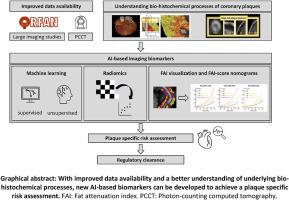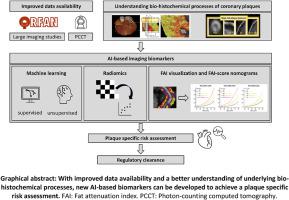利用人工智能研究计算机断层扫描成像中的动脉粥样硬化:最新文献综述
IF 4.9
2区 医学
Q1 CARDIAC & CARDIOVASCULAR SYSTEMS
引用次数: 0
摘要
近年来,随着心血管成像领域的巨大进步,计算机断层扫描(CT)已可随时用于冠状动脉粥样硬化疾病的表型分析。利用人工智能(AI)的新分析方法可以分析动脉粥样硬化斑块的复杂表型信息。特别是基于深度学习的卷积神经网络(CNN)方法,有助于完成病变检测、分割和分类等任务。新的放射转录组学技术甚至可以通过对 CT 图像上的体素进行高阶结构分析来捕捉潜在的生物组化过程。在不久的将来,国际大型牛津风险因素和无创成像(ORFAN)研究将为测试和验证基于人工智能的预后模型提供一个强大的平台。在这篇综述中,我们概述了现有的基于人工智能的技术,重点是确定冠状动脉炎症程度、冠状动脉斑块和相关风险的成像生物标志物。此外,我们还将讨论基于人工智能的方法目前存在的局限性以及应对这些挑战的优先事项。这将为人工智能风险评估工具检测易损动脉粥样硬化斑块和指导患者治疗策略铺平道路。本文章由计算机程序翻译,如有差异,请以英文原文为准。


Using artificial intelligence to study atherosclerosis from computed tomography imaging: A state-of-the-art review of the current literature
With the enormous progress in the field of cardiovascular imaging in recent years, computed tomography (CT) has become readily available to phenotype atherosclerotic coronary artery disease. New analytical methods using artificial intelligence (AI) enable the analysis of complex phenotypic information of atherosclerotic plaques. In particular, deep learning-based approaches using convolutional neural networks (CNNs) facilitate tasks such as lesion detection, segmentation, and classification. New radiotranscriptomic techniques even capture underlying bio-histochemical processes through higher-order structural analysis of voxels on CT images. In the near future, the international large-scale Oxford Risk Factors And Non-invasive Imaging (ORFAN) study will provide a powerful platform for testing and validating prognostic AI-based models. The goal is the transition of these new approaches from research settings into a clinical workflow.
In this review, we present an overview of existing AI-based techniques with focus on imaging biomarkers to determine the degree of coronary inflammation, coronary plaques, and the associated risk. Further, current limitations using AI-based approaches as well as the priorities to address these challenges will be discussed. This will pave the way for an AI-enabled risk assessment tool to detect vulnerable atherosclerotic plaques and to guide treatment strategies for patients.
求助全文
通过发布文献求助,成功后即可免费获取论文全文。
去求助
来源期刊

Atherosclerosis
医学-外周血管病
CiteScore
9.80
自引率
3.80%
发文量
1269
审稿时长
36 days
期刊介绍:
Atherosclerosis has an open access mirror journal Atherosclerosis: X, sharing the same aims and scope, editorial team, submission system and rigorous peer review.
Atherosclerosis brings together, from all sources, papers concerned with investigation on atherosclerosis, its risk factors and clinical manifestations. Atherosclerosis covers basic and translational, clinical and population research approaches to arterial and vascular biology and disease, as well as their risk factors including: disturbances of lipid and lipoprotein metabolism, diabetes and hypertension, thrombosis, and inflammation. The Editors are interested in original or review papers dealing with the pathogenesis, environmental, genetic and epigenetic basis, diagnosis or treatment of atherosclerosis and related diseases as well as their risk factors.
 求助内容:
求助内容: 应助结果提醒方式:
应助结果提醒方式:


